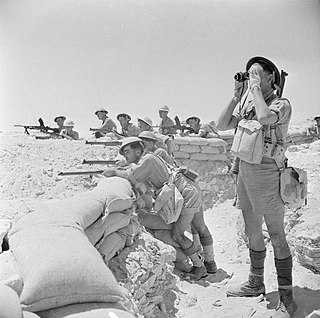
The First Battle of El Alamein was a battle of the Western Desert campaign of World War II, fought in Egypt between Axis forces of the Panzer Army Africa—which included the Afrika Korps under Field Marshal Erwin Rommel—and Allied forces of the Eighth Army under General Claude Auchinleck.

The 2nd New Zealand Division, initially the New Zealand Division, was an infantry division of the New Zealand Military Forces during the Second World War. The division was commanded for most of its existence by Lieutenant-General Bernard C. Freyberg. It fought in Greece, Crete, the Western Desert and Italy. In the Western Desert Campaign, the division played a prominent role in the defeat of German and Italian forces in the Second Battle of El Alamein and the British Eighth Army's advance to Tunisia.

XXX Corps was a corps of the British Army during the Second World War. The corps was formed in the Western Desert in September 1941. It provided extensive service in the North African Campaign and many of its units were in action at the Second Battle of El Alamein in late 1942. It then took part in the Tunisia Campaign and formed the left flank during the Allied invasion of Sicily in 1943.
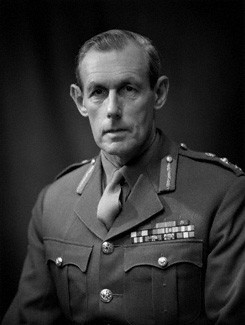
Field Marshal Richard Michael Power Carver, Baron Carver, was a senior British Army officer. Lord Carver served as the Chief of the General Staff (CGS), the professional head of the British Army, and then as the Chief of the Defence Staff (CDS), the professional head of the British Armed Forces. He served with distinction during the Second World War and organised the administration of British forces deployed in response to the Mau Mau Uprising in Kenya and later in his career provided advice to the British government on the response to the early stages of The Troubles in Northern Ireland.
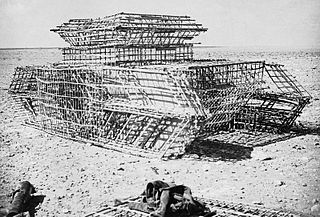
Operation Bertram was a Second World War deception operation practised by the Allied forces in Egypt led by Bernard Montgomery, in the months before the Second Battle of El Alamein in 1942. Bertram was devised by Dudley Clarke to deceive Erwin Rommel about the timing and location of the Allied attack. The operation consisted of physical deceptions using dummies and camouflage, designed and made by the British Middle East Command Camouflage Directorate led by Geoffrey Barkas. These were accompanied by electromagnetic deceptions codenamed Operation Canwell, using false radio traffic. All of these were planned to make the Axis believe that the attack would take place to the south, far from the coast road and railway, about two days later than the real attack.
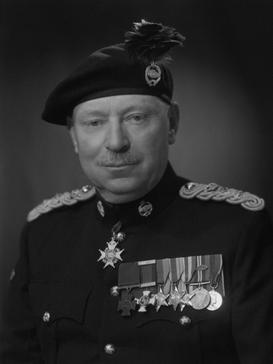
Major General Henry Robert Bowreman Foote, was a British Army officer and a recipient of the Victoria Cross, the highest award for gallantry in the face of the enemy that can be awarded to British and Commonwealth forces.

Lieutenant-General Herbert William Lumsden, was a senior British Army officer who fought in both the First and Second World Wars. He commanded the 1st Armoured Division in the Western Desert campaign, and later commanded X Corps at the Second Battle of El Alamein, before being relieved by his superior, Lieutenant General Bernard Montgomery. He was killed in action by the Japanese in early 1945, becoming the most senior combat casualty of the British Army of the Second World War.
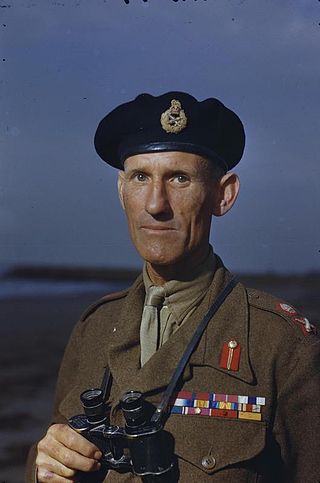
General Sir Richard Loudon McCreery, was a career soldier of the British Army, who was decorated for leading one of the last cavalry actions in the First World War. During the Second World War, he was chief of staff to General Sir Harold Alexander at the time of the Second Battle of El Alamein, and later commanded the British Eighth Army, fighting in the Italian campaign from October 1944 until the end of the war, leading it to victory in the final offensive in Italy.
Major General Sir Michael O'Moore Creagh, was a British Army officer who served in both the world wars. He commanded the 7th Armoured Division, the Desert Rats, between 1939 and 1941.
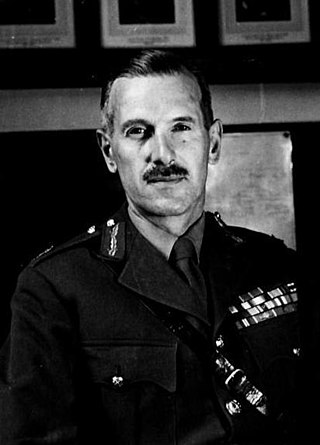
General Sir Sidney Chevalier Kirkman, was a British Army officer, who served in both the First World War and Second World War. During the latter he commanded the artillery of the Eighth Army during the Second Battle of El Alamein, following which he commanded the 50th Division during the Allied invasion of Sicily and XIII Corps throughout most of the Italian Campaign. He later became Director General of Civil Defence in the Civil Defence Department from 1954 to 1960.

The Royal Wiltshire Yeomanry (RWY) was a Yeomanry regiment of the Kingdom of Great Britain and the United Kingdom established in 1794. It was disbanded as an independent Territorial Army unit in 1967, a time when the strength of the Territorial Army was greatly reduced. The regiment lives on in B Squadron of the Royal Wessex Yeomanry.
Major-General Sir David Dawnay was a British Army officer who became Commandant of the Royal Military Academy Sandhurst. He was also a British polo player who competed in the 1936 Summer Olympics.
Brigadier John Cecil Currie was a British Army officer who fought in both the First and the Second World Wars.
Raymond Briggs was a senior British Army officer who fought in both the First and the Second World Wars. During the latter he led the 1st Armoured Division at the Second Battle of El Alamein in late 1942, and throughout the subsequent Tunisian campaign.
Major General Alexander Hugh Gatehouse, was a senior British Army officer who commanded the 10th Armoured Division during the North African campaign of the Second World War.
Brigadier Philip Ernest Bowden-Smith CBE, was a cavalry officer and later armoured commander of the British Army who served in the First World War and the Second World War. Described as 'one of the finest horsemen of his generation' he also represented Great Britain at the 1924 Olympic Games.
Major-General Sir Ivor Thomas Percival Hughes, was a senior British Army officer who fought in both the world wars. During the Second World War he commanded the 44th Division during the Battle of Alam el Halfa and the Second Battle of El Alamein in late 1942 and later became Serjeant-at-Arms of the House of Commons.
Major-General George Warren Richards (1898–1978) was a British Army officer.
Major-General Arthur Francis Fisher, was a British Army officer who served as acting General Officer Commanding 1st Armoured Division during the Second World War.
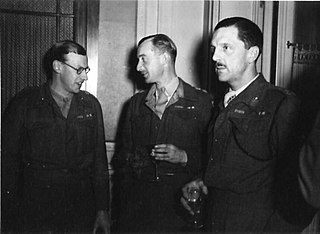
Ronald Frederick King "David" Belchem was a senior British Army officer who saw service in the Second World War.










